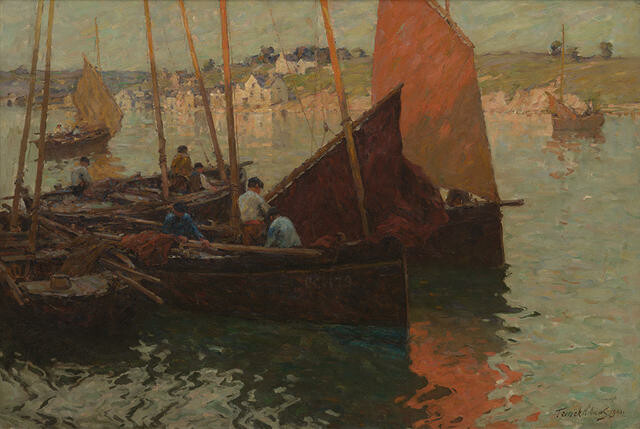Terrick John Williams
British, b.1860, d.1936
Evening, Concarneau
- 1901
- Oil on canvas
- Gift of the citizens of Christchurch to the Canterbury Society of Arts 1903, presented to the City 1932
- 1060 x 1462mm
- 69/374
- View on google maps
Tags: boats, buildings (structures), hills, houses, Impressionist (style), landscapes (representations), men (male humans), orange (color), people (agents), reflections (perceived properties), sails (equipment), seas, sunlight
Canterbury-born Sydney Lough Thompson once described the fishing port of Concarneau, in Brittany, France, as having as ‘an irresistible picturesqueness that attracts artists so strongly that it used to be known as the town “of thirty studios and thirty sardine factories”’. Thompson made Concarneau his base for the first time in 1902 and would spend most of the thirty years he lived in France there. Thompson bought Charles Fromuth’s 1904 pastel Dock study with Boats directly from the artist, an American who was so captivated by Concarneau from his arrival in 1890 that he based himself there for the rest of his life. Working almost exclusively in pastel, Fromuth’s enduring focus was on fishing boats, sails and rippling reflections. English painter Terrick Williams also became closely identified with this setting. Evening – Concarneau was one of the first four works from this location he exhibited at the Royal Academy in London, in 1902, the year before it came to Christchurch.
('The Weight of Sunlight, 16 September 2017 - 16 September 2018', where this work was displayed alongside 'Harbour Scene, Evening, Concarneau' by Sydney Lough Thompson and 'Dock study with Boats' by Charles Henry Fromuth.)
Concarneau scene by Thompson
Concarneau scene by Fromuth
Exhibition History
Concarneau Harbour is a picturesque seaside village in Brittany, France. At the turn of the century it was a popular location with plein air (outdoor) artists, among them Terrick Williams. The local fishing fleet was a popular subject and suited the more loosely painted modern styles of the time. Among the many artists attracted to the area were New Zealand painters Sydney Lough Thompson (1877-1973), Frances Hodgkins (1869 -1947) and Owen Merton (1887-1931). Williams was one of the British Impressionists who used a modified form of French Impressionist techniques. In Evening, Concarneau he pays close attention to the effects of light on water. A naturalistic painter, Williams applied thick layers of paint to achieve the lively effect of the water surface. Born in Liverpool, Williams studied art in Antwerp and Paris. He began exhibiting at the Royal Academy in 1888 and his works from Concarneau were exhibited there in 1910. Williams was made an Associate of the Academy in 1924. (Label date unknown)


